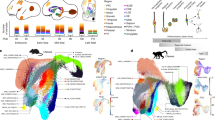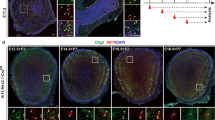Abstract
Adult neurogenesis in mammals is restricted to two small regions, including the olfactory bulb, where GABAergic and dopaminergic interneurons are newly generated throughout the entire lifespan. However, the mechanisms directing them towards a specific neuronal phenotype are not yet understood. Here, we demonstrate the dual role of the transcription factor Pax6 in generating neuronal progenitors and also in directing them towards a dopaminergic periglomerular phenotype in adult mice. We present further evidence that dopaminergic periglomerular neurons originate in a distinct niche, the rostral migratory stream, and are fewer derived from precursors in the zone lining the ventricle. This regionalization of the adult precursor cells is further supported by the restricted expression of the transcription factor Olig2, which specifies transit-amplifying precursor fate and opposes the neurogenic role of Pax6. Together, these data explain both extrinsic and intrinsic mechanisms controlling neuronal identity in adult neurogenesis.
This is a preview of subscription content, access via your institution
Access options
Subscribe to this journal
Receive 12 print issues and online access
$209.00 per year
only $17.42 per issue
Buy this article
- Purchase on Springer Link
- Instant access to full article PDF
Prices may be subject to local taxes which are calculated during checkout




Similar content being viewed by others
References
Arvidsson, A., Collin, T., Kirik, D., Kokaia, Z. & Lindvall, O. Neuronal replacement from endogenous precursors in the adult brain after stroke. Nat. Med. 8, 963–970 (2002).
Nakatomi, H. et al. Regeneration of hippocampal pyramidal neurons after ischemic brain injury by recruitment of endogenous neural progenitors. Cell 110, 429–441 (2002).
Altman, J. Autoradiographic and histological studies of postnatal neurogenesis. IV. Cell proliferation and migration in the anterior forebrain, with special reference to persisting neurogenesis in the olfactory bulb. J. Comp. Neurol. 137, 433–457 (1969).
Luskin, M.B. Restricted proliferation and migration of postnatally generated neurons derived from the forebrain subventricular zone. Neuron 11, 173–189 (1993).
Lois, C. & Alvarez-Buylla, A. Long-distance neuronal migration in the adult mammalian brain. Science 264, 1145–1148 (1994).
Kosaka, K. et al. Chemically defined neuron groups and their subpopulations in the glomerular layer of the rat main olfactory bulb. Neurosci. Res. 23, 73–88 (1995).
Saghatelyan, A., de Chevigny, A., Schachner, M. & Lledo, P.M. Tenascin-R mediates activity-dependent recruitment of neuroblasts in the adult mouse forebrain. Nat. Neurosci. 7, 347–356 (2004).
Kosaka, T., Hataguchi, Y., Hama, K., Nagatsu, I. & Wu, J.Y. Coexistence of immunoreactivities for glutamate decarboxylase and tyrosine hydroxylase in some neurons in the periglomerular region of the rat main olfactory bulb: possible coexistence of gamma-aminobutyric acid (GABA) and dopamine. Brain Res. 343, 166–171 (1985).
Kosaka, K., Toida, K., Aika, Y. & Kosaka, T. How simple is the organization of the olfactory glomerulus?: the heterogeneity of so-called periglomerular cells. Neurosci. Res. 30, 101–110 (1998).
Jessell, T.M. Neuronal specification in the spinal cord: inductive signals and transcriptional codes. Nat. Rev. Genet. 1, 20–29 (2000).
Bertrand, N., Castro, D.S. & Guillemot, F. Proneural genes and the specification of neural cell types. Nat. Rev. Neurosci. 3, 517–530 (2002).
Marin, O. & Rubenstein, J.L. A long, remarkable journey: tangential migration in the telencephalon. Nat. Rev. Neurosci. 2, 780–790 (2001).
Rallu, M., Corbin, J.G. & Fishell, G. Parsing the prosencephalon. Nat. Rev. Neurosci. 3, 943–951 (2002).
Marshall, C.A., Suzuki, S.O. & Goldman, J.E. Gliogenic and neurogenic progenitors of the subventricular zone: who are they, where did they come from, and where are they going? Glia 43, 52–61 (2003).
Doetsch, F., Caille, I., Lim, D.A., Garcia-Verdugo, J.M. & Alvarez-Buylla, A. Subventricular zone astrocytes are neural stem cells in the adult mammalian brain. Cell 97, 703–716 (1999).
Garcia, A.D., Doan, N.B., Imura, T., Bush, T.G. & Sofroniew, M.V. GFAP-expressing progenitors are the principal source of constitutive neurogenesis in adult mouse forebrain. Nat. Neurosci. 7, 1233–1241 (2004).
Doetsch, F., Petreanu, L., Caille, I., Garcia-Verdugo, J.M. & Alvarez-Buylla, A. EGF converts transit-amplifying neurogenic precursors in the adult brain into multipotent stem cells. Neuron 36, 1021–1034 (2002).
Capela, A. & Temple, S. LeX/ssea-1 is expressed by adult mouse CNS stem cells, identifying them as nonependymal. Neuron 35, 865–875 (2002).
Hack, M.A., Sugimori, M., Lundberg, C., Nakafuku, M. & Götz, M. Regionalization and fate specification in neurospheres: the role of Olig2 and Pax6. Mol. Cell. Neurosci. 25, 664–678 (2004).
Belluzzi, O., Benedusi, M., Ackman, J. & LoTurco, J.J. Electrophysiological differentiation of new neurons in the olfactory bulb. J. Neurosci. 23, 10411–10418 (2003).
Petreanu, L. & Alvarez-Buylla, A. Maturation and death of adult-born olfactory bulb granule neurons: role of olfaction. J. Neurosci. 22, 6106–6113 (2002).
Yamasaki, T. et al. Pax6 regulates granule cell polarization during parallel fiber formation in the developing cerebellum. Development 128, 3133–3144 (2001).
Mizuguchi, R. et al. Combinatorial roles of olig2 and neurogenin2 in the coordinated induction of pan-neuronal and subtype-specific properties of motoneurons. Neuron 31, 757–771 (2001).
Novitch, B.G., Chen, A.I. & Jessell, T.M. Coordinate regulation of motor neuron subtype identity and pan-neuronal properties by the bHLH repressor Olig2. Neuron 31, 773–789 (2001).
Ashery-Padan, R., Marquardt, T., Zhou, X. & Gruss, P. Pax6 activity in the lens primordium is required for lens formation and for correct placement of a single retina in the eye. Genes Dev. 14, 2701–2711 (2000).
Haubst, N. et al. Molecular dissection of Pax6 function: the specific roles of the paired domain and homeodomain in brain development. Development 131, 6131–6140 (2004).
Heins, N. et al. Glial cells generate neurons: the role of the transcription factor Pax6. Nat. Neurosci. 5, 308–315 (2002).
Lee, S.K., Lee, B., Ruiz, E.C. & Pfaff, S.L. Olig2 and Ngn2 function in opposition to modulate gene expression in motor neuron progenitor cells. Genes Dev. 19, 282–294 (2005).
Lu, Q.R. et al. Common developmental requirement for Olig function indicates a motor neuron/oligodendrocyte connection. Cell 109, 75–86 (2002).
Winner, B., Cooper-Kuhn, C.M., Aigner, R., Winkler, J. & Kuhn, H.G. Long-term survival and cell death of newly generated neurons in the adult rat olfactory bulb. Eur. J. Neurosci. 16, 1681–1689 (2002).
Brunjes, P.C. Unilateral naris closure and olfactory system development. Brain Res. Brain Res. Rev. 19, 146–160 (1994).
Gabay, L., Lowell, S., Rubin, L. & Anderson, D. Deregulation of dorsoventral patterning by FGF confers trilineage differentiation capacity on CNS stem cells in vitro. Neuron 40, 485–499 (2003).
Zhou, Q. & Anderson, D.J. The bHLH transcription factors OLIG2 and OLIG1 couple neuronal and glial subtype specification. Cell 109, 61–73 (2002).
Gritti, A. et al. Multipotent neural stem cells reside into the rostral extension and olfactory bulb of adult rodents. J. Neurosci. 22, 437–445 (2002).
Wichterle, H., Garcia-Verdugo, J.M. & Alvarez-Buylla, A. Direct evidence for homotypic, glia-independent neuronal migration. Neuron 18, 779–791 (1997).
Beech, R.D. et al. Nestin promoter/enhancer directs transgene expression to precursors of adult generated periglomerular neurons. J. Comp. Neurol. 475, 128–141 (2004).
Bedard, A. & Parent, A. Evidence of newly generated neurons in the human olfactory bulb. Brain Res. Dev. Brain Res. 151, 159–168 (2004).
Sanai, N. et al. Unique astrocyte ribbon in adult human brain contains neural stem cells but lacks chain migration. Nature 427, 740–744 (2004).
Huisman, E., Uylings, H.B. & Hoogland, P.V. A 100% increase of dopaminergic cells in the olfactory bulb may explain hyposmia in Parkinson's disease. Mov. Disord. 19, 687–692 (2004).
Pfeifer, A., Brandon, E.P., Kootstra, N., Gage, F.H. & Verma, I.M. Delivery of the Cre recombinase by a self-deleting lentiviral vector: efficient gene targeting in vivo. Proc. Natl. Acad. Sci. USA 98, 11450–11455 (2001).
Pfeifer, A., Ikawa, M., Dayn, Y. & Verma, I.M. Transgenesis by lentiviral vectors: lack of gene silencing in mammalian embryonic stem cells and preimplantation embryos. Proc. Natl. Acad. Sci. USA 99, 2140–2145 (2002).
Acknowledgements
We are particularly grateful to M. Nakafuku for the pMXIG Olig2 and pMXIG Olig2 VP16 constructs; N. Osumi for the pMESPax6engrailed construct; M. Wegner for the antisera directed against Sox10 and P. Durbec for providing PSANCAM antibodies. We also thank A. Bust, M. Öcalan and S. Ankri for excellent technical help. This work was supported by the Deutsche Forschungsgemeinschaft (M.G.) and by the Pasteur Institute (P.M.L., GPH no. 7, 'Stem cells') and the Centre National de la Recherche Scientifique and A.S. was supported by a postdoctoral fellowship from the Pasteur Institute and the Association Française Contre les Myopathies. R.A.-P. is supported by the Israel Science Foundation (401/02) and the German-Israeli Foundation for Scientific Research and Development.
Author information
Authors and Affiliations
Corresponding authors
Ethics declarations
Competing interests
The authors declare no competing financial interests.
Supplementary information
Supplementary Fig. 1
Comparison of Pax6 and Olig2 dominant-negative and loss-of-function viral manipulations. (PDF 537 kb)
Rights and permissions
About this article
Cite this article
Hack, M., Saghatelyan, A., de Chevigny, A. et al. Neuronal fate determinants of adult olfactory bulb neurogenesis. Nat Neurosci 8, 865–872 (2005). https://doi.org/10.1038/nn1479
Received:
Accepted:
Published:
Issue Date:
DOI: https://doi.org/10.1038/nn1479
This article is cited by
-
Restoration of Adult Neurogenesis by Intranasal Administration of Gangliosides GD3 and GM1 in The Olfactory Bulb of A53T Alpha-Synuclein-Expressing Parkinson’s-Disease Model Mice
Molecular Neurobiology (2023)
-
The rates of adult neurogenesis and oligodendrogenesis are linked to cell cycle regulation through p27-dependent gene repression of SOX2
Cellular and Molecular Life Sciences (2023)
-
Seed-induced Aβ deposition alters neuronal function and impairs olfaction in a mouse model of Alzheimer’s disease
Molecular Psychiatry (2022)
-
Co-expression and Interaction of Pax6 with Genes and Proteins of Immunological Surveillance in the Brain of Mice
Neurotoxicity Research (2022)
-
Transcriptional cooperation of PBX1 and PAX6 in adult neural progenitor cells
Scientific Reports (2021)



